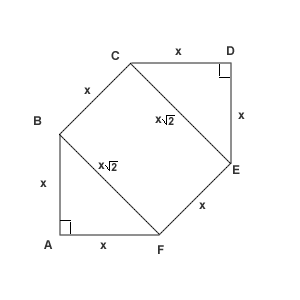Difference between revisions of "2006 AIME II Problems/Problem 1"
(→Solution) |
|||
| Line 21: | Line 21: | ||
Therefore, <math>AB</math> is <math>\boxed{046}</math>. | Therefore, <math>AB</math> is <math>\boxed{046}</math>. | ||
| + | |||
| + | == Solution == | ||
| + | |||
| + | Because <math>\angle | ||
| + | B</math>, <math>\angle C</math>, <math>\angle E</math>, and <math>\angle F</math> are congruent, the degree-measure of each of them is <math>\displaystyle | ||
| + | {{720-2\cdot90}\over4}= 135</math>. Lines <math>BF</math> and <math>CE</math> divide the hexagonal region into two right triangles and a rectangle. Let <math>AB=x</math>. Then <math>BF=x\sqrt2</math>. Thus \begin{align*} | ||
| + | 2116(\sqrt2+1)&=[ABCDEF]\\ | ||
| + | &=2\cdot {1\over2}x^2+x\cdot x\sqrt2=x^2(1+\sqrt2), | ||
| + | \end{align*}so <math>x^2=2116</math>, and <math>x=\boxed{46}</math>. | ||
| + | |||
| + | [asy] | ||
| + | pair A,B,C,D,I,F; | ||
| + | A=(0,0); | ||
| + | B=(7,0); | ||
| + | F=(0,7); | ||
| + | I=(6,13); | ||
| + | D=(13,13); | ||
| + | C=(13,6); | ||
| + | dot(A); | ||
| + | dot(B); | ||
| + | dot(C); | ||
| + | dot(D); | ||
| + | dot(I); | ||
| + | dot(F); | ||
| + | draw(A--B--C--D--I--F--cycle,linewidth(0.7)); | ||
| + | label("{\tiny <math>A</math>}",A,S); | ||
| + | label("{\tiny <math>B</math>}",B,S); | ||
| + | label("{\tiny <math>C</math>}",C,E); | ||
| + | label("{\tiny <math>D</math>}",D,N); | ||
| + | label("{\tiny <math>E</math>}",I,N); | ||
| + | label("{\tiny <math>F</math>}",F,W); | ||
| + | [/asy] | ||
== See also == | == See also == | ||
Revision as of 01:09, 3 May 2016
Contents
Problem
In convex hexagon ![]() , all six sides are congruent,
, all six sides are congruent, ![]() and
and ![]() are right angles, and
are right angles, and ![]() and
and ![]() are congruent. The area of the hexagonal region is
are congruent. The area of the hexagonal region is ![]() Find
Find ![]() .
.
Solution
Let the side length be called ![]() , so
, so ![]() .
.
The diagonal ![]() . Then the areas of the triangles AFB and CDE in total are
. Then the areas of the triangles AFB and CDE in total are ![]() ,
and the area of the rectangle BCEF equals
,
and the area of the rectangle BCEF equals ![]()
Then we have to solve the equation
![]() .
.
![]()
![]()
Therefore, ![]() is
is ![]() .
.
Solution
Because ![]() ,
, ![]() ,
, ![]() , and
, and ![]() are congruent, the degree-measure of each of them is
are congruent, the degree-measure of each of them is ![]() . Lines
. Lines ![]() and
and ![]() divide the hexagonal region into two right triangles and a rectangle. Let
divide the hexagonal region into two right triangles and a rectangle. Let ![]() . Then
. Then ![]() . Thus \begin{align*}
2116(\sqrt2+1)&=[ABCDEF]\\
&=2\cdot {1\over2}x^2+x\cdot x\sqrt2=x^2(1+\sqrt2),
\end{align*}so
. Thus \begin{align*}
2116(\sqrt2+1)&=[ABCDEF]\\
&=2\cdot {1\over2}x^2+x\cdot x\sqrt2=x^2(1+\sqrt2),
\end{align*}so ![]() , and
, and ![]() .
.
[asy]
pair A,B,C,D,I,F;
A=(0,0);
B=(7,0);
F=(0,7);
I=(6,13);
D=(13,13);
C=(13,6);
dot(A);
dot(B);
dot(C);
dot(D);
dot(I);
dot(F);
draw(A--B--C--D--I--F--cycle,linewidth(0.7));
label("{\tiny ![]() }",A,S);
label("{\tiny
}",A,S);
label("{\tiny ![]() }",B,S);
label("{\tiny
}",B,S);
label("{\tiny ![]() }",C,E);
label("{\tiny
}",C,E);
label("{\tiny ![]() }",D,N);
label("{\tiny
}",D,N);
label("{\tiny ![]() }",I,N);
label("{\tiny
}",I,N);
label("{\tiny ![]() }",F,W);
[/asy]
}",F,W);
[/asy]
See also
| 2006 AIME II (Problems • Answer Key • Resources) | ||
| Preceded by First Question |
Followed by Problem 2 | |
| 1 • 2 • 3 • 4 • 5 • 6 • 7 • 8 • 9 • 10 • 11 • 12 • 13 • 14 • 15 | ||
| All AIME Problems and Solutions | ||
These problems are copyrighted © by the Mathematical Association of America, as part of the American Mathematics Competitions. ![]()










